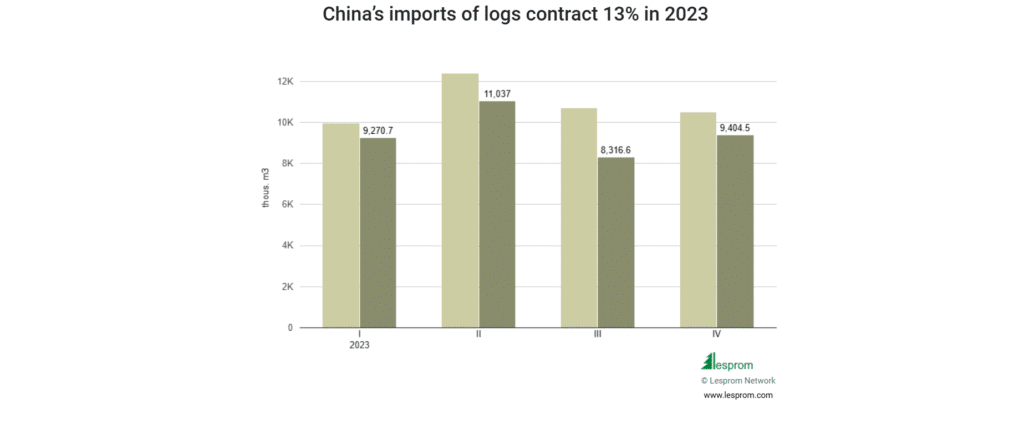The Chinese housing market is collapsing, with the sale value of new houses across 70 of China’s largest cities falling by almost 26% last month compared to 12 months ago. The fall has led to the world’s largest consumer market taking much less sawlog and lumber.
That is according to China Customs, which reports that Chinese importers are taking 30% less sawlog (2,695 thousand cubic metres for June, down from 3,837 thousand cubic metres) and 16% less lumber (2,221 thousand cubic metres, down from 2,583 thousand cubic metres).
And the problem could get much, much worse with JP Morgan’s Chief China economist, Haibin Zhu, part of a growing number of economists predicting that the downtown could last for several years: “We have lowered our forecast for China’s gross domestic product (GDP) for this year to 4.7%, down from 5.2%, which reflects the ongoing difficulties faced by the real estate market.”

Despite Beijing’s efforts, including a $42 billion lending program to reduce the housing backlog, uptake has been slow. Until the end of June, just 4% of the allocated funds had been used, with banks reluctant to lend to state-owned companies.
Wood Central understands that Beijing remains cautious about large-scale fiscal stimulus, now crunched by rising government debt and declining land-sale revenues. It comes as a bid by the International Monetary Fund (IMF) for a $1 trillion housing rescue plan was rejected by China, wary of setting expectations for future government interventions.
Is China’s hot and cold log and lumber markets in deep trouble?
According to data reported by China Customs, birch sawlog (from Russia) is down 41% to 79,600 cubic metres, and NZ radiata pine, which now makes up 46% of log imports, contracted 27%, from 1,710 thousand cubic metres to 1,255 thousand cubic metres. The latest data continues a long-term trend of softer imports, with China taking 13% far fewer imports in 2023 (38,028.8 thousand cubic metres) compared to 2022 (43,603.9 thousand cubic metres).

“It’s important to note that China is coming off a peak in log demand that will likely not be matched for a very long time,” according to Rudolf van Rensburg, co-author of China – Forest, Log & Lumber Outlook – a 197-page report looking at supply log and lumber into the Chinese economy.
In addition to softer log imports, China’s traders are also taking far less volumes of lumber. According to China Customs, timber imports were down 14% for June, accelerating from a 7% drop for the April-to-June quarter. Russian lumber is now responsible for almost 46% of all lumber traded into China (or 3,228 thousand cubic metres out of 7,242 thousand cubic metres).
The latest data comes after the Chinese government released its latest gross domestic product (or GDP) numbers, showing that Chinese economic growth has slowed to 4.75% compared to the rapid annual economic growth rate of 7 and 8% during the 2010s heyday.

Despite lumber imports increasing 5% from 2022 to 2023, Chinese traders are now taking less lumber amid concerns that the Chinese government could follow Japan into long-term decline.
“This should be a wake-up call for Chinese economic policymakers. It should be viewed as confirmation that the Chinese economy is in deep trouble and that its economic growth model is now well past its sell-by date,” according to Desmond Lachman, an expert in macroeconomic policy. “Unless the Chinese government introduces major structural economic reforms that encourage domestic consumer spending, China could experience a Japanese-style lost economic decade,” Mr Lachman wrote in equity markets publication Seeking Alpha last month.
“That could have major consequences for the world economic outlook given that China is the world’s second-largest economy and, until recently, was the world’s main engine of economic growth and its main consumer of international commodities.”

“The root cause of China’s present economic problems is the highly unbalanced economic model that it has pursued over the past 30 years. China excessively relied on investment in general and housing investment in particular to drive economic growth, adding that it has become overly dependent on exports and a steady supply of cheap labour from its agricultural sector.”
- Visit Wood Central’s special feature to learn more about China’s log and lumber markets and their impact on the global supply chains for timber-based products.






